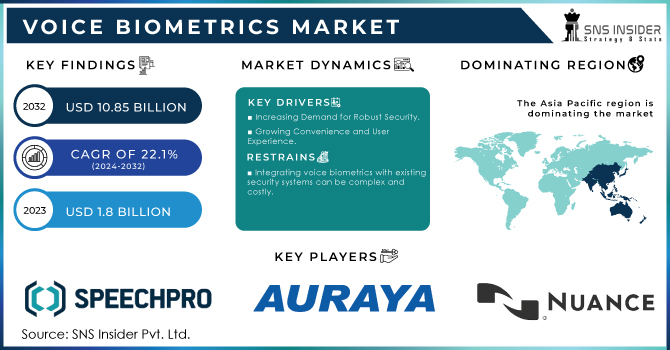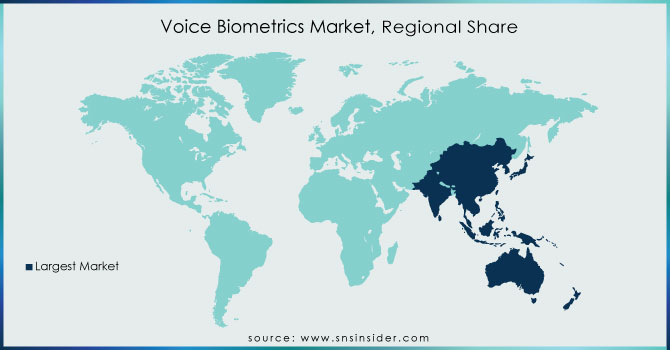Voice Biometrics Market Report Scope & Overview:
The Voice Biometrics Market Size was $1.8 billion in 2023 and is expected to reach USD 10.85 billion by 2032 and grow at a CAGR of 22.1% by 2024-2032.

Get more Information on Voice Biometrics Market - Request Sample Report
The growing use of voice biometrics technology in FinTech will fuel the market growth. Banking services have become convenient and accessible to a large number of people around the world through internet banking and digital revolution. The expansion of comfortable banking services and improved customer experience is good to voice biometrics in the banking sector the user's journey has been rapid, swift and effective. Voice banking is conquering the financial industry, and FinTechs are competing to offer more advanced, robust, and secure solutions. The development of voice banking is predicted to move in several directions in the next few years. According to Intelligent Software Engineering, 18 million US consumers have already tried paying by voice, and many banks and financial institutions offer this service to their clients. The banking sector is expected to register a significant growth rate over the forecast period, owing to the higher adoption of voice recognition in mobile and web banking applications.
Voice Biometrics Market Dynamics:
KEY DRIVERS:
-
Increasing Demand for Robust Security
-
Growing Convenience and User Experience
Financial institutions like banks are constantly battling fraud. Voice biometrics offers a robust security solution. When a customer calls their bank's customer service line, for instance, voice biometric technology can verify their identity through unique vocal characteristics before accessing sensitive information. This reduces the risk of unauthorized access and financial fraud.
RESTRAINTS:
-
Integrating voice biometrics with existing security systems can be complex and costly.
-
Security and Privacy Issues Due to The Advances in Technology
Due to the Security and Privacy fact samples are kept locally, and they use for other purposes beyond primary reasons of collection, voice biometrics pose a significant privacy issue. Fraudsters and hackers may easily gain access to the system through any common application that uses voice technology, which could allow for easy theft of a voice sample. Fraudsters can easily access any user's bank account and steal money if they have access to all the customer information.
OPPORTUNITIES:
-
Integration of Advanced Technologies provides various opportunities.
Continuous advancements in artificial intelligence and machine learning are improving the accuracy and security of voice biometrics. This will lead to wider adoption across various industries. Also, the increasing dominance of smartphones creates a perfect opportunity for voice biometrics. Imagine using your voice to unlock your phone or make secure payments – this level of convenience can significantly drive market growth.
CHALLENGES:
-
The lack of standardized formats for voice data can hinder interoperability between different systems.
-
The evolving regulatory environment regarding data privacy can create challenges for companies implementing voice biometric solutions.
The lack of universal standards for voice biometric data collection and storage can create compatibility issues between different systems. Industry-wide collaboration is needed to establish common standards.
IMPACT OF RUSSIA-UKRAINE WAR
The Russia-Ukraine conflict heighten concerns about security and espionage, prompting governments and organizations to enhance their security measures. Voice biometrics may find growing use as a technique of confirming identities and preventing illegal access to sensitive data. A law requiring banks and state agencies to include their clients' biometric data, including facial photos and voice samples in a central biometrics database has been adopted by the Russian legislature. The measure will come into force in March 2023, and does not impose any requirement for banks to obtain the consent of their clients before giving them data and it appears to be a coordinated effort to prepare for the new regulation. It is likely that such a move will be aimed at increasing the collection of biometric data and ultimately sharing them with the government. The threat of monitoring for Russians living in Russia has been significantly increased by the government's expansion of biometric collection through banks and national authorities. Individuals are required to give their consent for the collection and Componenting of biometric data under Russian legislation on personal data. While Russian banks have collected biometric data on millions of clients over the years, the vast majority of clients have been reluctant to grant permission for their data to be shared with the government.
IMPACT OF ECONOMIC SLOWDOWN
The adoption rate may fall by 15-20% compared to periods of economic boom. Change in Priorities Organizations may prioritize investments in technology that directly contribute to revenue creation or cost savings over those aimed at increasing security or user experience. This move could reduce voice biometrics adoption by 15%. A typical reduction might be between 20 and 30 percent of the money allotted to such technology. Slower adoption rate. Businesses with tight finances may postpone or scale back their ambitions to use voice biometrics solutions. Contact centres are facing an increasingly difficult situation. The industry is in desperate need of transformation in the area of contact centre security, in an environment where the rate of contact centre fraud has increased by 350% over the last four years, coupled with increasing customer expectations. In recent years, security has become a priority for many sectors, and contact centres have become a major target for fraud. Many websites are available on internet tat offering voice biometric option with 96% accuracy in 28-29 languages and more than 40-50 accents. Professional models of voice cloning, which can replicate any tone, rhythm and detail, are also available. With smartphones and apps, biometric authentication is now widely accepted as well with other digital channels such as web applications or automated interactive voice response IVR systems which are increasingly driven by artificial intelligence and machine learning technologies. Only voice biometrics can offer the same customer experience in all channels, and it's a biometric that really operates as an Omni modality. In view of the fact that voice is now considered to be the most effective human machine interface.
Voice Biometrics Market Segment Overview
By Authentication Process
Based on Authentication Process, Mobile applications is a dominating segment, due to the widespread use of smartphones. Integrating voice biometrics into banking apps, e-wallets, and other mobile services provides a convenient and secure way to authenticate users. The mobile application segment is also experiencing the fastest growth due to several factors such as Increasing smartphone penetration, Emerging applications etc. also Automated IVR systems are widely used in customer service for tasks like account verification or password resets. Voice biometrics can streamline this process by automatically identifying and authenticating callers.
Voice Biometrics Market Regional Analysis
The Asia Pacific region is expected to be the fastest-growing market for voice biometrics globally. The widespread adoption of smartphones in APAC creates a perfect platform for voice biometric integration. Financial institutions and other businesses can leverage smartphone voice authentication for secure mobile banking and other services.. Many APAC governments are actively promoting digitalization and cashless transactions. also APAC governments are actively creating regulations around data privacy and security. This will encourage the development and adoption of secure voice biometric solutions. For example, in 2020, China released its "Voice Biometric Information Protection Standard," which outlines data security measures for the industry. Voice biometrics offers a secure and convenient way to verify identities for these initiatives, boosting its adoption in sectors like public services and social welfare programs. For instance, in India, the government's Aadhaar program, a unique digital identity system, is exploring the use of voice biometrics for authentication.
North America, is the largest revenue generator which is expected to grow at a compound annual growth rate of 19.4% over the forecast period. Voice recognition is being applied in a variety of applications, the increasing adoption of mobile and cloud technology as well as significant technological advances with regards to computer performance. In the forecast period, Europe is expected to grow at a compound annual growth rate of 19.71%. In the United Kingdom, HSBC has integrated voice recognition technology into its banking system. It's aimed at improving security. Although the company has installed fingerprint scanners in its mobile application, there are other banks that offer this technology. There are two ways in which the bank uses voice recognition technology and fingerprint scanners on its mobile devices. To improve its current mass surveillance and social control operations, the Government of China has lately increased use of biometrics including development of a large database of fingerprint data. The speech pattern database is far less developed compared with the majority of police-run biometrics databases due to its smaller sample size. In the next two to three years, the Chinese startup iFlytek plans to make its voice recognition software widely available.

Get Customized Report as per Your Business Requirement - Request For Customized Report
KEY PLAYERS:
The major key players are SpeechPro, Auraya, Nuance, Verint, Pindrop, NICE, LexisNexis Risk Solutions, Phonexia, Aculab, OneVault, Aware, and other key players.
Recent Developments:
March 2024, In Voice Authentication for Metaverse Access.
A leading cybersecurity firm announced a pilot program with a metaverse platform to explore using voice biometrics for secure user logins within virtual environments. This signifies the potential for voice biometrics beyond traditional security applications.
In April 2024, Amazon Voice ID Update.
Amazon unveiled an update to its Amazon Voice ID platform that improves speaker verification accuracy in noisy environments. This addresses a key challenge in the field and demonstrates continuous advancements in voice biometric technology.
| Report Attributes | Details |
|---|---|
| Market Size in 2023 | US$ 1.8 Billion |
| Market Size by 2032 | US$ 10.85 Billion |
| CAGR | CAGR of 22.1% From 2024 to 2032 |
| Base Year | 2023 |
| Forecast Period | 2024-2032 |
| Historical Data | 2020-2022 |
| Report Scope & Coverage | Market Size, Segments Analysis, Competitive Landscape, Regional Analysis, DROC & SWOT Analysis, Forecast Outlook |
| Key Segments | • By Component (Solution (Software, Platform), Services (Professional Services, Managed Services)) • By Type (Active Voice, Passive Voice) • By Authentication Process (Automated IVR, Agent-Assisted, Mobile Applications, Employee Authentication) • By Deployment Mode (On-Premise, Cloud) • By Organization Size (SME’s, Large Enterprise) • By Applications (Forensic Voice Analysis and Criminal Investigation, Access Control, Fraud detection and Prevention, Authentication and Customer Verification, Transaction Processing, Risk and Emergency Management, Workforce Management, Others) • By Vertical (IT & Telecom, BFSI, Government, Healthcare, Retail, Transportation and Logistics, Travel and Hospitality, Energy and Utility, Others) |
| Regional Analysis/Coverage | North America (US, Canada, Mexico), Europe (Eastern Europe [Poland, Romania, Hungary, Turkey, Rest of Eastern Europe] Western Europe [Germany, France, UK, Italy, Spain, Netherlands, Switzerland, Austria, Rest of Western Europe]), Asia Pacific (China, India, Japan, South Korea, Vietnam, Singapore, Australia, Rest of Asia Pacific), Middle East & Africa (Middle East [UAE, Egypt, Saudi Arabia, Qatar, Rest of Middle East], Africa [Nigeria, South Africa, Rest of Africa], Latin America (Brazil, Argentina, Colombia, Rest of Latin America) |
| Company Profiles | Nuance, NICE, Verint, Pindrop LexisNexis Risk Solutions, Phonexia, Aculab, Auraya, OneVault, Aware, SpeechPro |
| KEY DRIVERS |
• In large sectors, there is an increasing demand for sophisticated fraud detection and prevention systems. |
| Restraints | • Because of modern technologies, there are security and privacy concerns. • Low cybersecurity expenditures are accompanied by high installation expenses. |

